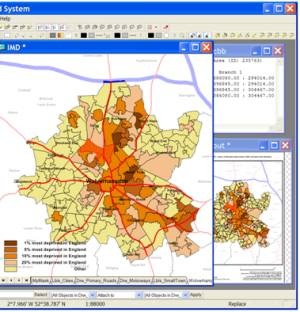If it were necessary to provide a course of Manifold in just two days, this would be the course outline. The fields marked as practical should be done hands on work, using a step by step exercise.
 First day
First day
1. GIS Principles
- What is GIS
- Differences between raster and vector data
- Cartographic Projections
- Free Resources
2. Manifold Basic Operation (Practice)
- Importing data
- Assigning a projection
- Display and navigation of drawings and tables
- Creating a new map
- Working with layers in a map
- Selecting, creating, editing objects in drawings and tables
- Using the Info tool
- Saving a new project
3. Cartographic communication
- Accepted concepts in cartographic view
- Theming formats
- Colors and simbology
- Differences between deployment and printing
4. Drawing theming format (Practice)
- In the theming deployment
- Drawings formats
- Setting of polygon, point and line formats
- Settings in the Map component
- Creating labels
- Thematic Mapping
- Issues for theming
- Adding legends
5. Creating un Map (Practice)
- Cartographic principles to be considered
- Layout’s definition
- Layout’s elements (text, images, legends, scale bar, north arrow)
- Exporting layouts
- Printing a Map
Second day
6. Database Introduction
- What is a RDBMS
- Database design (indexing, keys, integrity and normalization)
- Geographic data storing in a RDBMS
- Principles of the SQL Language
7. Accessing a Database (Practice)
- Importing data
- Linking a table with an external RDBMS
- Linked Drawings
- Joining tabular data to drawings
- Tables design
- Selection bar
- Queries Bar
8. Processing data using SQL (Practice)
- SQL Queries
- SQL Action queries
- Query parameters
- SQL Spatial queries
9. Spatial Analysis (Practice)
- Principles of Spatial Analysis
- Spatial Selection using different operators
- Spatial Overlay
- Creating areas of influence (buffers) and centroids
- Shortest route
- Points’ density
Based on the defined theme for the course that will be held in the University College London (UCL) in the course that will be taught on 12 and 13 February 2009
 Autocad Software, Bentley Microstation, Gis Google Earth, Gis System Geomate Provides Services For Complete Gis Software And Solutions, Autocad Software, Autocad Courses, Bentley Microstation, Microstation Software, Gis Google Earth, Open Source Gis And More.
Autocad Software, Bentley Microstation, Gis Google Earth, Gis System Geomate Provides Services For Complete Gis Software And Solutions, Autocad Software, Autocad Courses, Bentley Microstation, Microstation Software, Gis Google Earth, Open Source Gis And More.